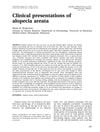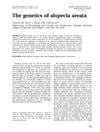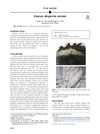TLDR Alopecia areata is an autoimmune disease causing hair loss, treatable with immune-modulating drugs, and linked to genetics.
Alopecia areata (AA) was identified as an autoimmune disease characterized by nonscarring hair loss, often associated with other autoimmune conditions. The presence of autoreactive T lymphocytes supported its autoimmune etiology, with both CD4+ and CD8+ T cells playing roles in its pathogenesis. Studies showed that AA could be transferred to human scalp explants on SCID mice using T lymphocytes, indicating a T cell-mediated mechanism. Immune modulating drugs, such as corticosteroids, were beneficial in managing AA. Genetic predisposition was suggested by associations with certain HLA alleles, and AA was observed to have a protective effect against Type I diabetes. Animal models were used to study AA's pathophysiology and test therapies. Neuropeptides and altered cutaneous innervation were implicated, with a pilot study using capsaicin cream showing vellus hair regrowth. The document emphasized the need for further research into treatments and genetic studies.
 13 citations
,
December 2001 in “Dermatologic therapy”
13 citations
,
December 2001 in “Dermatologic therapy” Alopecia areata causes varying hair loss patterns, affecting hair, nails, and possibly glands, with treatment outcomes depending on disease duration and extent.
 19 citations
,
December 2001 in “Dermatologic Therapy”
19 citations
,
December 2001 in “Dermatologic Therapy” Horizontal scalp biopsy sections are better for diagnosing alopecia areata, showing fewer hair follicles and more miniaturized hairs.
 16 citations
,
December 2001 in “Dermatologic Therapy”
16 citations
,
December 2001 in “Dermatologic Therapy” Alopecia areata has a complex genetic basis that was not fully understood as of 2001.
72 citations
,
September 1997 in “Journal of Investigative Dermatology”  36 citations
,
October 1996 in “Dermatologic Clinics”
36 citations
,
October 1996 in “Dermatologic Clinics” Mice are useful for researching human hair loss and testing treatments, despite some differences between species.
178 citations
,
June 1994 in “Journal of Investigative Dermatology” Alopecia areata in these mice is inherited, more common in young females, and can be treated with triamcinolone acetonide.
 6 citations
,
March 2019 in “JAAD case reports”
6 citations
,
March 2019 in “JAAD case reports” A new mix of anthralin and calcipotriene might help treat severe hair loss.
 148 citations
,
December 2018 in “Journal of autoimmunity”
148 citations
,
December 2018 in “Journal of autoimmunity” Alopecia areata is an autoimmune disease causing patchy hair loss, often with other autoimmune disorders, but its exact causes are unknown.
 4 citations
,
November 2018 in “JAAD case reports”
4 citations
,
November 2018 in “JAAD case reports” Alopecia areata can sometimes appear as a straight line of hair loss instead of round patches.
May 2018 in “Journal of cosmetology & trichology” Combining platelet-rich plasma therapy with prostaglandin-F eye drops can significantly regrow hair in alopecia universalis.







